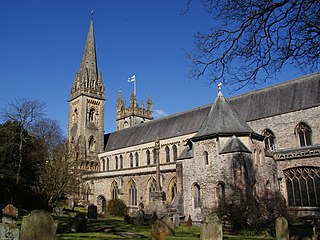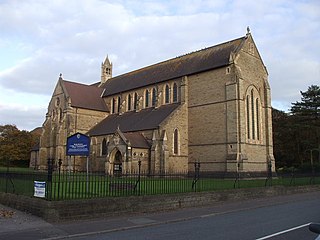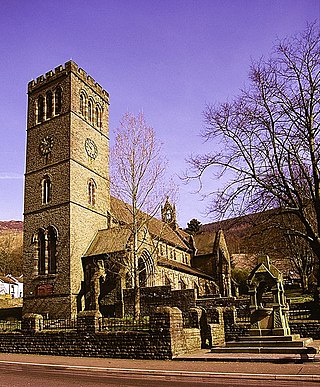
Port Talbot is a town and community in the county borough of Neath Port Talbot, Wales, situated on the east side of Swansea Bay, approximately eight miles from Swansea. The Port Talbot Steelworks covers a large area of land which dominates the south east of the town. It is one of the biggest steelworks in the world, but has been under threat of closure since the 1980s. The population was 31,550 in 2021, comprising about a fifth of the 141,931 population of Neath Port Talbot.

Llandaff Cathedral is an Anglican cathedral and parish church in Llandaff, Cardiff, Wales. It is the seat of the Bishop of Llandaff, head of the Church in Wales Diocese of Llandaff. It is dedicated to Saint Peter and Saint Paul, and three Welsh saints: Dubricius, Teilo and Oudoceus. It is one of two cathedrals in Cardiff, the other being the Roman Catholic Cardiff Metropolitan Cathedral in the city centre.

Baglan is a village in Wales, adjoining Port Talbot, named after Saint Baglan. It is also a community and ward in the Neath Port Talbot county borough. In 2001, the population was 6,654. rising to 6,819 in 2011.

The Diocese of Llandaff is an Anglican diocese that traces its roots to pre-Reformation times as heir of a Catholic bishopric. It is headed by the Bishop of Llandaff, whose seat is located at the Cathedral Church of Saint Peter and Saint Paul in Llandaff, a suburb of Cardiff. It currently covers most of the former Welsh county of Glamorgan, but once stretched from the River Towy to the middle of the Wye Valley.
Saint Baglan was a 6th-century hermit who lived at Baglan in Wales.

Alfred Ollivant was an academic who went on to become Bishop of Llandaff.

St Padarn's Institute came into being in 2016. Until then the site belonged to St Michael's College, an Anglican theological college in Llandaff, Wales. St Michael's college was founded in Aberdare in 1892, and was situated in Llandaff from 1907 until 2016. Among its many alumni was the poet R. S. Thomas. The original building on the site was a house constructed for himself by John Prichard. After his death, that building was incorporated into the newly founded St Michael's College, which was built mainly to the designs of F. R. Kempson between 1905 and 1907. In the late 1950s, a chapel was built by George Pace. The college had significant financial problems in the early 21st century and was eventually closed.
This article is about the particular significance of the year 1882 to Wales and its people.
This article is about the particular significance of the year 1849 to Wales and its people.

John Prichard was a Welsh architect in the neo-Gothic style. As diocesan architect of Llandaff, he was involved in the building or restoration of many churches in south Wales.
Pentre is a village, community and electoral ward near Treorchy in the Rhondda valley, falling within the county borough of Rhondda Cynon Taf, Wales. The village's name is taken from the Welsh word Pentref, which translates as homestead, though Pentre is named after a large farm that dominated the area before the coming of industrialisation. The community takes in the neighbouring village of Ton Pentre.

St Peter's Church is a Church of England parish church at Dixton in Wales. It is situated on the banks of the River Wye, about 1 mile (1.6 km) north-east of Monmouth, Wales. The church is a Grade II* listed building and the cross in the churchyard is both a listed building and a scheduled monument.

The Church of St Teilo is the parish church of Llantilio Crossenny, Monmouthshire, Wales. "An unusually grand cruciform church", with an Early English tower crossed by a Decorated chancel, it was designated a Grade I listed building on 19 November 1953

Llantrisant Church is located in Llantrisant, Rhondda Cynon Taf, Glamorgan, Wales. Built within a short distance of Llantrisant Castle, it was originally in the Norman style of architecture. When described in History of Llantrisant, Glamorganshire (1898), little of the original church remained, with the only traces of Norman architecture being the baptismal font, a portion of the south door, and the lower part of the western arch of the nave. The tower, which is about 70 feet (21 m) high, contains a peal of six bells. The living is a vicarage. Llantrisant Church is a Grade II* listed building.

The Church of St Theodore is a parish church of the Church in Wales in Port Talbot, Wales. Located on the A48 opposite Maes-y-Cwrt Terrace and bordered on two sides by the Talbot Memorial Park, it is administered within the diocese of Llandaff.
Albert John Pitman is regarded by change ringing campanologists as a remarkable and versatile composer of peals in bell ringing methods. Described as 'perhaps the greatest of all time' in the Central Council of Church Bell Ringers biography of him, An Unassuming Genius, he was an extraordinary talent in the field of peal composition.

St Elvan's Church is a Grade II* listed Anglican church in the centre of the town of Aberdare. It was built in 1851–1852, largely at the instigation of John Griffith, vicar of Aberdare from 1847 until 1859.

The Church of St Teilo, Llanarth, Monmouthshire, Wales is a former parish church with its origins in the 15th century. Renovations took place in the 18th, 19th and 20th centuries. It is a Grade II* listed building and is now a redundant church, having closed in 2013.

St Catherine's Church, Canton is a listed Anglican church which serves the areas of Canton and Riverside in Cardiff, Wales.

St Peter's Church is an Anglican church serving the parish of Ystradyfodwg and the village of Pentre in Rhondda Cynon Taf, Wales. It is located on Pentre Road, with the south-west end of its churchyard fronting the main thoroughfare of Llewellyn Street (A4058). It was built in the Early English style in 1887–1890 to the designs of Kempson and Fowler and was designated as a Grade II* listed building in 1991.















